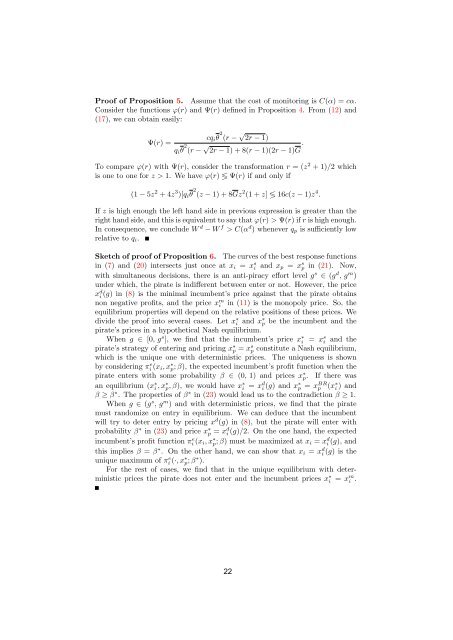Download PDF - Ivie
You also want an ePaper? Increase the reach of your titles
YUMPU automatically turns print PDFs into web optimized ePapers that Google loves.
Proof of Proposition 5. Assume that the cost of monitoring is C(α) = cα.<br />
Consider the functions ϕ(r) and Ψ(r) defined in Proposition 4. From (12) and<br />
(17), we can obtain easily:<br />
Ψ(r) =<br />
cq i θ 2 (r − √ 2r − 1)<br />
q i θ 2 (r − √ 2r − 1) + 8(r − 1)(2r − 1)G .<br />
To compare ϕ(r) with Ψ(r), consider the transformation r = (z 2 + 1)/2 which<br />
is one to one for z > 1. We have ϕ(r) ≶ Ψ(r) if and only if<br />
(1 − 5z 2 + 4z 3 )[q i θ 2 (z − 1) + 8Gz 2 (1 + z] ≶ 16c(z − 1)z 4 .<br />
If z is high enough the left hand side in previous expression is greater than the<br />
right hand side, and this is equivalent to say that ϕ(r) > Ψ(r) if r is high enough.<br />
In consequence, we conclude W d − W f > C(α d ) whenever q p is sufficiently low<br />
relative to q i .<br />
Sketch of proof of Proposition 6. The curves of the best response functions<br />
in (7) and (20) intersects just once at x i = x s i and x p = x s p in (21). Now,<br />
with simultaneous decisions, there is an anti-piracy effort level g s ∈ (g d , g m )<br />
under which, the pirate is indifferent between enter or not. However, the price<br />
x d i (g) in (8) is the minimal incumbent’s price against that the pirate obtains<br />
non negative profits, and the price x m i in (11) is the monopoly price. So, the<br />
equilibrium properties will depend on the relative positions of these prices. We<br />
divide the proof into several cases. Let x ∗ i and x ∗ p be the incumbent and the<br />
pirate’s prices in a hypothetical Nash equilibrium.<br />
When g ∈ [0, g s ], we find that the incumbent’s price x ∗ i = x s i and the<br />
pirate’s strategy of entering and pricing x ∗ p = x s p constitute a Nash equilibrium,<br />
which is the unique one with deterministic prices. The uniqueness is shown<br />
by considering πi e(x i, x ∗ p; β), the expected incumbent’s profit function when the<br />
pirate enters with some probability β ∈ (0, 1) and prices x ∗ p. If there was<br />
an equilibrium (x ∗ i , x∗ p, β), we would have x ∗ i = x d i (g) and x∗ p = x BR<br />
p (x ∗ i ) and<br />
β ≥ β ∗ . The properties of β ∗ in (23) would lead us to the contradiction β ≥ 1.<br />
When g ∈ (g s , g m ) and with deterministic prices, we find that the pirate<br />
must randomize on entry in equilibrium. We can deduce that the incumbent<br />
will try to deter entry by pricing x d (g) in (8), but the pirate will enter with<br />
probability β ∗ in (23) and price x ∗ p = x d i (g)/2. On the one hand, the expected<br />
incumbent’s profit function πi e(x i, x ∗ p; β) must be maximized at x i = x d i (g), and<br />
this implies β = β ∗ . On the other hand, we can show that x i = x d i (g) is the<br />
unique maximum of πi e(·, x∗ p; β ∗ ).<br />
For the rest of cases, we find that in the unique equilibrium with deterministic<br />
prices the pirate does not enter and the incumbent prices x ∗ i = x m i .<br />
20

















